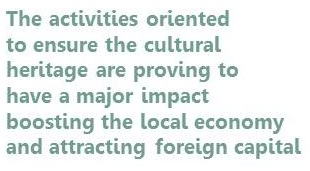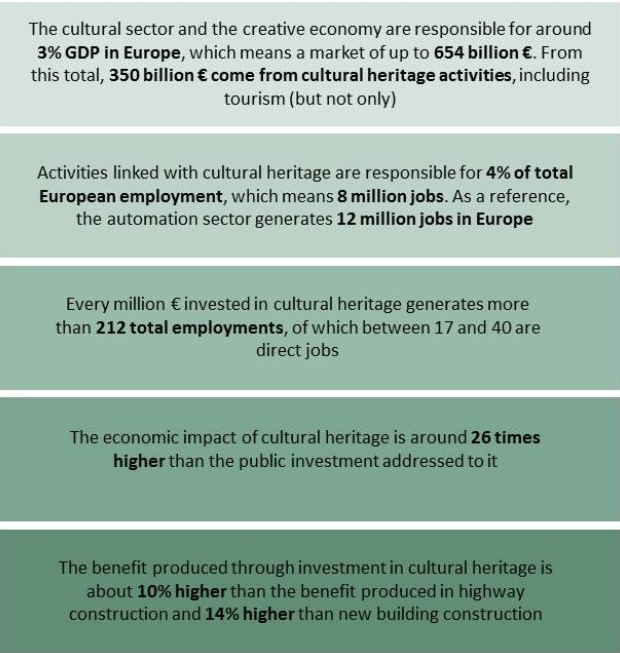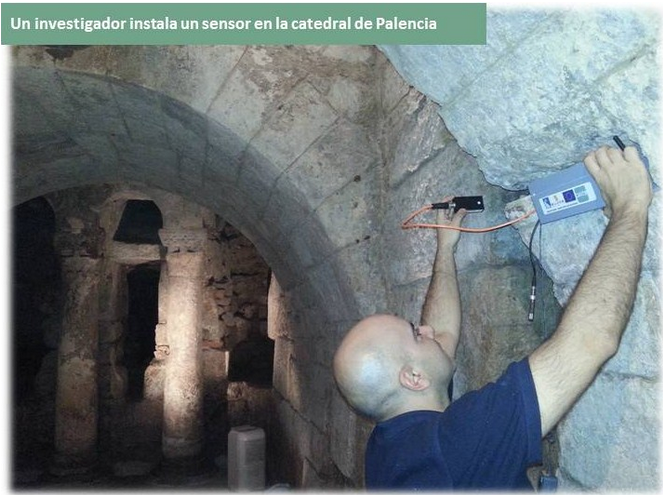Have you ever thought on the importance of the monuments close to you?. Do you happen to know they really are a source of employment and local development?. Here you are a few lines to explain it, and also to make you understand how the applied RTD is effectively contributing to the study, protection, conservation, refurbishment and reuse of cultural heritage.

Since 1999, with the Florence Conference, and later with the World Bank and the UNESCO reports, cultural heritage is considered a rightful source of socio-economic development for the countries. It is really a form of capital that the economist David Throsby noted as ‘cultural capital’, i.e. an asset with specific key features (the economic value is added to the cultural value -primordial, symbolic, intangible-).
Europe is the region that counts with the most important and the richest cultural heritage all over the world. This contributes to attract millions of tourists every year. Obviously it helps to create jobs and enhances the quality of life of European citizens while reinforcing a common shared identity.
The European Union Treaty (Article 167) specifies that safeguarding cultural heritage (moveable and immoveable) must be treated as a priority for the EU and is the legal basis for protection initiatives including research on cultural heritage. Besides, UNESCO expressly states that “the protection of cultural heritage, as an expression of living culture, contributes to the development of societies and the building of peace”.
The protection and preservation of important monuments and sites is more pressing than ever as cultural heritage is exposed to pollution, climate change and socio-economic pressures. According to specialists in the field, the activities oriented to ensure the sustainability of heritage are proving to have a major impact boosting the local economy and attracting foreign capital (because of related cultural tourism).
The following figures emerging from the EVoCH Platform within CARTIF is a founding member, will take you on the way of we are talking about:

The recognition of the importance of the mentioned aspects leads cultural heritage to be considered into specific RTD proposals in the current EU Research and Innovation programme (Horizon 2020). In fact, since 1986 the EU has been supporting research for the preservation of tangible cultural heritage to develop ‘state of the art’ methodologies, tools and products.
During the last years, a few successful results of technology transfer are giving evidence that the most effective and practical way of supporting and developing innovative services, is a collaboration between applied research organizations and enterprises to make these fit ICT tools into their daily work. In CARTIF, we have been working in this field more than 15 years. Some of our projects, INCEPTION, COST Action i2MHB, SHBUILDINGS, RENERPATH or 3D Virtual Restoration of Historical Paintings, have developed the most innovative technologies.

This means that new technological solutions are really the basis to meet actual demands on the five internationally recognised levels of intervention on cultural heritage: study, protection, conservation, restoration and dissemination. Only in this way, reliable, fast, easy-to-use and affordable tools will be available to shift the very traditional procedures of those levels to the 21st century we are living in.
Consequently stable and high-quality associated skilled jobs will be created, directly related to an intrinsic and non-transferable resource such cultural heritage is by itself.
- Artificial Intelligence and Cultural Heritage: A Promising Alliance (With Nuances) - 7 November 2025
- The black gold of Castilla y León: its Cultural Heritage - 5 December 2024
- Talking about everything visible and invisible (II) - 30 August 2024
